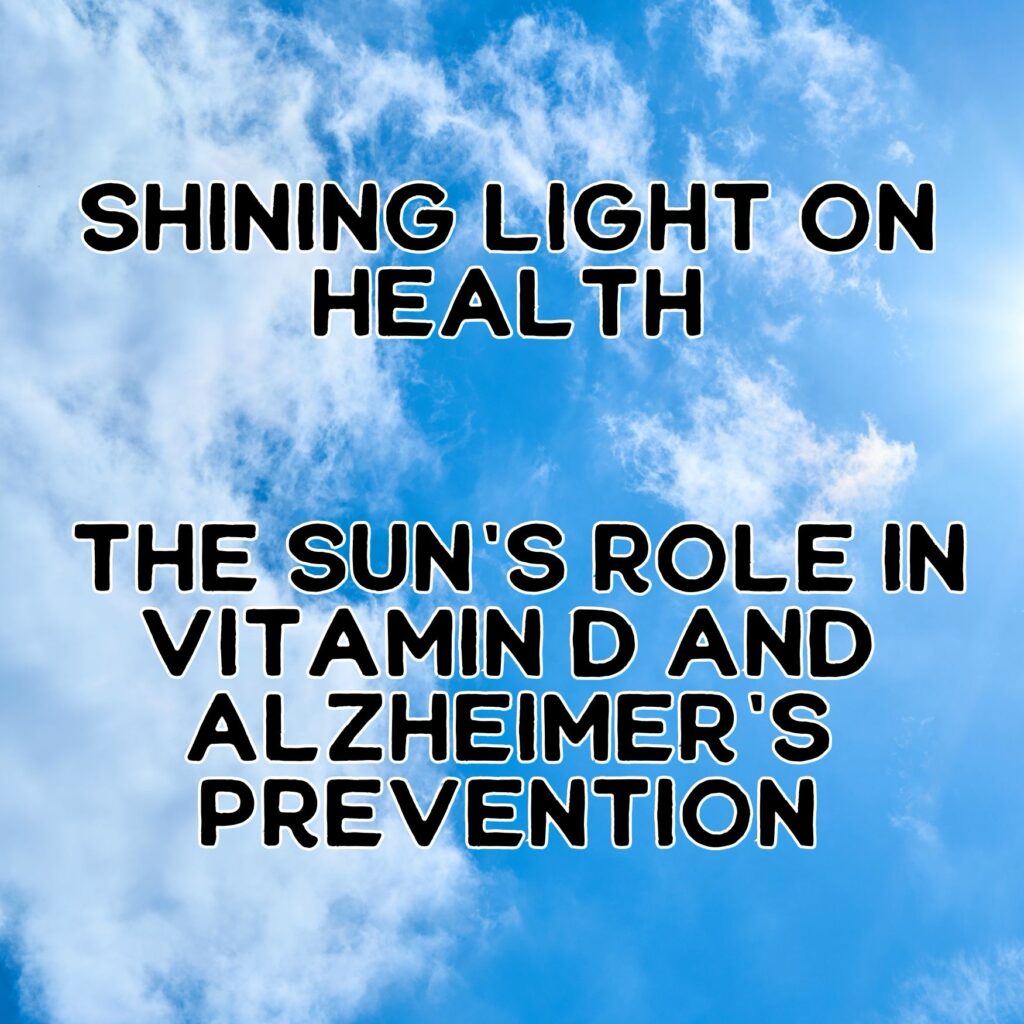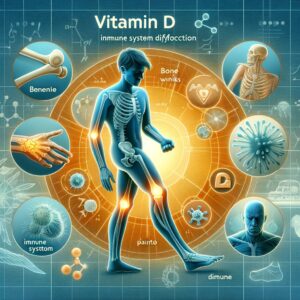
Vitamin D, often referred to as the “sunshine vitamin,” is a crucial nutrient that plays a vital role in numerous bodily functions. Unlike other essential vitamins, vitamin D functions like a hormone, and every cell in your body has a receptor for it. Its primary role is to maintain normal blood levels of calcium and phosphorus, helping to build and maintain strong bones. However, vitamin D’s role extends beyond bone health.
Recent research has uncovered the broader impacts of vitamin D on our health. It is pivotal in supporting immune function, brain health, and nervous system regulation. It also plays a role in regulating mood and warding off depression. Surprisingly, despite its importance, vitamin D deficiency is one of the most common health issues worldwide.
Adequate levels of vitamin D are critical for ensuring our body’s cells function properly. Without it, we are at an increased risk of various health complications, including bone disorders like osteoporosis, certain types of cancer, cardiovascular disease, and autoimmune problems. This introduction sets the stage for a deeper understanding of the link between sunlight, vitamin D, and our health, especially considering the high prevalence of vitamin D deficiency and its implications.

The Link Between Sunlight and Vitamin D
Sunlight is nature’s prescription for maintaining optimal levels of vitamin D, a crucial nutrient for our well-being. When our skin is exposed to sunlight, specifically ultraviolet B (UVB) rays, it naturally produces vitamin D. This process is so efficient that for most people, just 10-30 minutes of midday sun exposure several times a week can maintain healthy vitamin D levels. However, the modern lifestyle, characterized by indoor work and limited outdoor activities, often leads to inadequate sun exposure, contributing to widespread vitamin D deficiency.

Geographic location, season, time of day, cloud cover, smog, skin melanin content, and sunscreen use are all factors that affect UV radiation exposure and vitamin D synthesis. For instance, people living far from the equator may not get enough UVB rays during the winter months. Additionally, sunscreen, while essential for protecting against skin cancer, can also significantly reduce the body’s ability to produce vitamin D.
This direct link between sunlight and vitamin D production raises a challenge: how do we balance the need for sufficient vitamin D with the risks associated with overexposure to the sun’s rays? The answer lies in understanding and managing our sun exposure and exploring alternative sources of vitamin D, which becomes crucial for individuals unable to receive adequate sunlight.
In the next section, we will delve into understanding vitamin D deficiency – its causes, prevalence, and health implications, laying the groundwork for exploring solutions to this hidden yet widespread health concern.

Understanding Vitamin D Deficiency
Vitamin D deficiency has become a global health issue, affecting approximately 50% of the population worldwide. This deficiency is not just a concern for bone health, but it has broader implications for overall well-being and disease prevention. Understanding the causes and consequences of vitamin D deficiency is crucial for addressing this silent health concern.
Causes of Vitamin D Deficiency:
- Limited Sunlight Exposure: One of the primary reasons for vitamin D deficiency is inadequate exposure to sunlight, often due to lifestyle choices, living in higher latitudes, or wearing clothing that covers most of the skin.
- Dietary Shortcomings: Few foods naturally contain vitamin D, making it challenging to obtain sufficient amounts from diet alone.
- Increased Needs or Inability to Absorb Vitamin D: Certain groups, like the elderly, those with darker skin, and people with medical conditions like Crohn’s disease or celiac disease, may have increased needs or a decreased ability to absorb vitamin D.
Health Risks Associated with Vitamin D Deficiency: Vitamin D deficiency can lead to a range of health problems, including:
- Bone and Muscle Weakness: Vitamin D is essential for calcium absorption, and its deficiency can lead to conditions like osteoporosis and muscle weakness.
- Immune System Dysfunction: It plays a critical role in immune function, and its deficiency is linked to an increased risk of infections and autoimmune diseases.
- Chronic Diseases: Emerging research suggests links between vitamin D deficiency and various chronic conditions, including cardiovascular diseases, certain cancers, and depression.
Given the widespread nature of vitamin D deficiency and its potential health risks, it’s essential to identify and address this issue. In the following sections, we will explore the connection between vitamin D and brain health, specifically its role in reducing the risk of Alzheimer’s disease, and discuss alternative sources of vitamin D.

Vitamin D and Brain Health: Reducing Alzheimer’s Risk
Recent research has shed light on a remarkable aspect of vitamin D – its potential role in brain health and reducing the risk of Alzheimer’s disease. Alzheimer’s, a debilitating neurodegenerative disease, poses significant challenges to individuals, families, and healthcare systems. Interestingly, studies suggest that maintaining adequate levels of vitamin D can play a part in mitigating this risk.
The Link Between Vitamin D and Brain Function: Vitamin D receptors are found throughout the brain, indicating its role in brain function and health. Deficiency in vitamin D has been associated with an increased risk of cognitive decline and dementia, including Alzheimer’s disease.
Research Findings: One groundbreaking study found that vitamin D supplementation could decrease the risk of developing Alzheimer’s by up to 40%. These findings are significant, considering the current lack of effective long-term treatments for Alzheimer’s. The research suggests that vitamin D may help protect the brain against the processes that lead to the disease, such as inflammation and amyloid plaque buildup.
Mechanism of Action: While the exact mechanisms are still being understood, vitamin D is believed to play a role in clearing amyloid plaques, a hallmark of Alzheimer’s disease. It also has anti-inflammatory and immune-boosting properties that might contribute to maintaining overall brain health.
Implications for Prevention and Management: These findings underline the importance of maintaining adequate vitamin D levels for brain health, especially in older adults who are at a higher risk for Alzheimer’s. While it’s not a standalone cure or prevention method, it represents a potentially significant piece in the complex puzzle of Alzheimer’s disease.
As we move to the next section, we will explore alternative sources of vitamin D, highlighting ways to maintain adequate levels, particularly for those with limited sun exposure.
Alternative Sources of Vitamin D
For individuals who have limited sun exposure, there are alternative ways to ensure adequate intake of vitamin D:
- Dietary Sources: While few foods naturally contain vitamin D, some good sources include fatty fish (like salmon and tuna), fish liver oils, egg yolks, and fortified foods such as milk, orange juice, and cereals.
- Vitamin D Supplements: These are a practical option for many people. Supplements come in two forms: D2 (ergocalciferol) and D3 (cholecalciferol). D3, derived from animal sources, is generally recommended as it is more effective at raising blood levels of vitamin D.
Guidelines for Vitamin D Supplementation
When considering vitamin D supplements, keep the following in mind:
- Consult a Healthcare Provider: It’s essential to talk to your doctor before starting any supplement, especially if you have health conditions or are taking other medications.
- Recommended Dosage: The recommended dietary allowance (RDA) for most adults is 600-800 IU of vitamin D per day. However, some may need higher doses, especially those with a diagnosed deficiency.
- Monitoring Vitamin D Levels: Regular blood tests can help monitor your vitamin D levels and adjust your supplement dosage as needed.
Vitamin D, a vital nutrient for bone health, immune function, and brain health, is often overlooked in our daily lives. Understanding the importance of maintaining adequate vitamin D levels and the various ways to achieve this, especially for those with limited sun exposure, is essential for overall health and well-being.
Questions and Answers
Can I get enough vitamin D from my diet alone? For most people, it’s challenging to get the required amount of vitamin D from diet alone. Incorporating fortified foods and considering supplements, especially during winter months or if you have limited sun exposure, can help meet the body’s needs.
Are there any risks associated with taking vitamin D supplements? Taking too much vitamin D can lead to health issues like hypercalcemia. It’s important to follow recommended guidelines and consult with a healthcare provider before starting supplements.
How does vitamin D deficiency affect children and adolescents? In children and adolescents, severe vitamin D deficiency can lead to rickets, a condition where the bones become soft and weak. Ensuring adequate vitamin D intake is crucial for their growing bodies.
Can wearing sunscreen prevent vitamin D synthesis? Sunscreen can reduce the body’s ability to produce vitamin D. However, it’s important for skin cancer prevention. Balancing sun protection with brief sun exposure, and considering dietary sources or supplements, can help maintain healthy vitamin D levels.
As an Amazon Associate we earn from qualifying purchases through some links in our articles.




